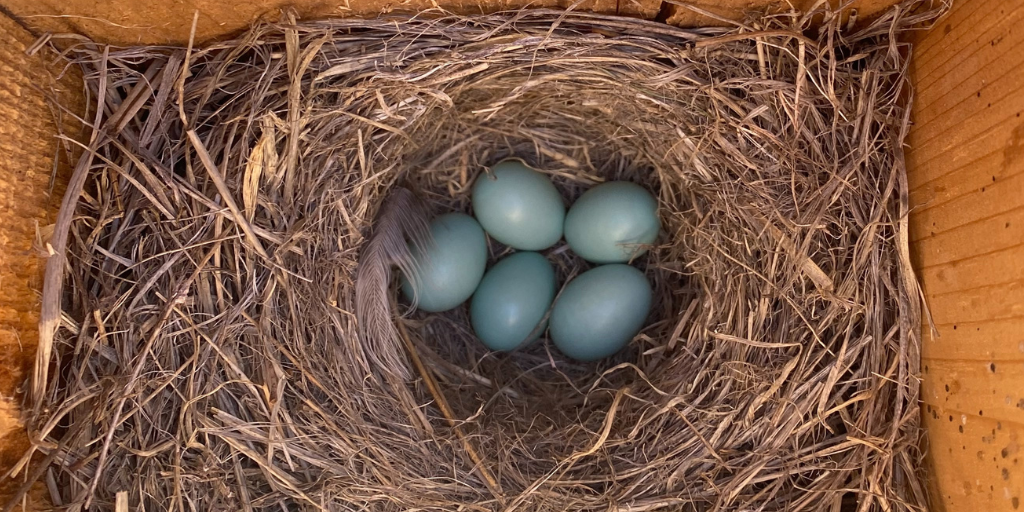Some of my earliest memories growing up in North Carolina are intertwined with the melodious song and vibrant feathers of the Eastern Bluebird (Sialia sialis). With their bright blue plumage and rusty chest, they are one of the most recognizable birds along the east coast. My backyard was a haven for these birds and every spring, I eagerly awaited the sight of bluebird nests in my family’s backyard nest boxes. These birds brought me much joy and a sense of connection to nature. I often spent hours observing their behavior, noting how they cared for their young and defended their territory. These experiences instilled in me a deep appreciation for wildlife and conservation that I carried into adulthood.
Moving to Arizona was a big transition from the lush green forests of North Carolina to the rugged deserts of the Southwest. When one thinks of the birds of the Sonoran Desert, your mind may bring up images of roadrunners darting through the brush, vultures soaring high above along cliff faces, or Great Horned Owls perched upon the towering saguaro cacti at dusk, but if you look close enough you may see a flash of brilliant blue against the rocky backdrop. Unknown to most, Arizona is home to a unique and distinct subspecies of the Eastern Bluebird, known as the Azure Bluebird (Sialia sialis fulva).

During the last glacial maximum, the Eastern Bluebirds were split into two lineages. While one spread from the east coast, the Azure Bluebirds originated from the south, moving up through Mexico. Today, this species is only found in the Sierra Madre Occidental sky islands in northern Mexico and southeastern Arizona. Azure Bluebirds are smaller than their east coast cousins ranging about 5.5-7.5 inches in length, exhibit paler plumage, and have a shortened and higher pitched song. They are highly picky when selecting their nesting habitat and only reside amidst the live oak savannahs found around 4000-6000 feet in the sky island mountains. The reliance on this particular habitat has been to their detriment, as much of the oak savannah and grasslands that they utilize have been lost due to agricultural use or human encroachment which has led to them being listed as vulnerable and a species of greatest conservation need by Arizona Game and Fish.
Males and females are easy to distinguish, with males boasting bright royal blue feathers and a cinnamon-colored breast patch while females display more grayish blue plumage with some azure females almost completely lacking the red breast patch altogether. While foraging, they can be seen in trees scanning the grass below, and suddenly diving from their perch to the ground almost raptor-like in pursuit of small insects such as grasshoppers and caterpillars. Like all bluebirds, they are secondary cavity nesters and are highly reliant on species such as Acorn Woodpeckers to form the tree cavities that they eventually use to raise their own young. They often will use nestboxes installed by humans as well. Males select the cavity in early spring, and the females then get to work constructing cup nests made of grass and lay an average clutch size of five bright blue eggs. The female will incubate the eggs for two weeks and afterwards the nestlings take around two weeks to grow and fledge.
I first became interested in the Azure Bluebirds during the first year of my PhD. During the summer, I scoured the entire southern border of Arizona where these shy birds have been spotted and located several sites to construct nest box trails to hopefully establish resident populations. I spent nearly every day observing them and soon noticed several interesting behaviors that distinguish them from other Eastern Bluebirds. I’m particularly interested in their plumage and how they use it to signal to one another. It is well documented that bluebird plumage is used as an indicator of mate quality, age, and other traits. I’m taking that further to look at the genetic correlations between plumage color and behavior and studying the ecological and evolutionary dynamics involved in the development of these traits. Ultimately, I want to see how plumage can be related to range dynamics and territory acquisition. In the face of a changing climate and growing human populations, it is especially important to understand the processes involved in how these organisms interact with each other and arrange themselves in the environment. This can lead to management practices to best conserve this at-risk and charismatic bird of the Sonoran sky islands.
Interested in attracting bluebirds to your yard? Read here to learn more about the habitat requirements for these birds as well as step by step instructions for constructing your own nest box.



